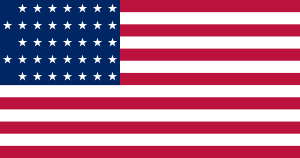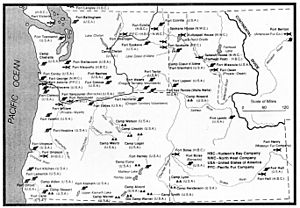1st Oregon Infantry Regiment facts for kids
Quick facts for kids 1st Oregon Infantry Regiment |
|
|---|---|

Flag of the United States, 1867-1877
|
|
| Active | 11 November 1864 – 19 July 1867 |
| Country | United States |
| Allegiance | Union |
| Branch | Infantry |
| Engagements | Harney Lake Valley |
The 1st Oregon Infantry Regiment was a group of soldiers from Oregon who served during the American Civil War. They were part of the Union Army, which fought to keep the United States together. This regiment was created in November 1864.
At its strongest, the regiment had ten groups of foot soldiers, called companies. Their main jobs were to protect important trade routes. They also helped guide groups of settlers, called wagon trains, traveling from Fort Boise to the Willamette Valley. These soldiers also tracked down and stopped Native American groups in eastern Oregon and the Idaho Territory. Some soldiers helped survey land and build roads in central and southern Oregon. The last group of soldiers from this regiment finished their service in July 1867.
Contents
Why Was the Regiment Formed?
When the Civil War started in 1861, many regular army soldiers left the Pacific Northwest. They went to fight in the main war areas back east. This left Oregon and the Washington and Idaho territories with few soldiers.
There weren't enough troops to protect Native American lands from miners. They also needed soldiers to guard immigrant wagon trains. And they had to keep settlers and traders safe from Native American groups in eastern Oregon and southern Idaho. Leaders in Oregon were also worried about fights between people who supported the Union and those who supported the Confederacy.
Because of these worries, a general named George Wright asked Oregon's Governor, John Whiteaker, to form a new group of soldiers. This group would be a cavalry regiment, meaning soldiers who ride horses. At the same time, Washington Territory also formed its own infantry (foot soldier) regiment.
How the Regiment Was Created
Many soldiers who had joined earlier groups were finishing their service in 1864. So, General Benjamin Alvord asked Oregon's new Governor, Addison C. Gibbs, to create a new infantry regiment. He also asked for new soldiers to replace those leaving the cavalry.
Governor Gibbs agreed. He asked for permission to recruit more soldiers for operations in Oregon. On August 31, 1864, Gibbs and General Irwin McDowell sent a letter to the War Department in Washington, D.C. They asked to recruit a new infantry regiment and cavalry replacements.
On October 20, 1864, the War Department said yes. This news came just one day before Oregon's lawmakers finished their session. Governor Gibbs quickly asked them to offer a $150 bonus for joining the army. The lawmakers approved this bonus before going home.
Governor Gibbs chose well-known community leaders to help recruit soldiers. Newspapers like The Oregonian and the Oregon Statesman encouraged young men to join. This publicity, along with the $150 bonus, made the recruiting successful. The first companies of the 1st Oregon Volunteer Infantry Regiment officially started on November 11, 1864. By June 1865, the regiment had ten full companies.
Three senior officers from the 1st Oregon Cavalry were promoted to lead the new infantry regiment. Colonel George B. Currey became the commander. Lieutenant Colonel John M. Drake was second in command. And Major William V. Rinehart was the third most senior officer.
What Did They Do?
While some groups from the 1st Oregon Volunteer Infantry Regiment sometimes fought with Native American bands, their main jobs were often less exciting. Most companies spent their time guarding small forts in eastern Oregon, southeast Washington, and southern Idaho.
They protected trails used by immigrants and guided wagon trains from Fort Boise to the Willamette Valley. Two companies helped survey land. Another company built a road in southwestern Oregon.
A Close Call for Captain Williams
Captain Loren L. Williams and twenty Oregon infantrymen from Company H were scouting near present-day Burns. They were attacked by a group of Native Americans. Williams and his soldiers fought their way back to Camp Wright, defending themselves for about fifteen hours. The Native Americans fired from hidden spots and even set a brush fire to block their escape.
Despite the constant attacks, only two soldiers were wounded. Captain Williams reported that his long-range rifles killed fifteen Native Americans. He believed their better weapons were the only reason they weren't completely defeated.
Guarding Wagon Trains and Building Camps
In the summer of 1865, Lieutenant Cyrus H. Walker and Company B had important jobs. They disarmed friendly Native Americans and guarded many wagon trains crossing southern Idaho. They also set up two new camps in Idaho: Camp Reed and Camp Wallace. The soldiers built a strong blockhouse at Camp Wallace. Later, they moved to winter quarters near Fort Hall.
Surveying and Road Building
Lieutenant William Grant and his group went with David P. Thompson's survey team through central Oregon. They were mapping the Deschutes Meridian, a north-south line from the Columbia River to the California border.
In another project, Lieutenant John M. McCall led forty-eight men. They escorted State Surveyor Byron J. Pengra as he mapped the route for the Oregon Central Military Road. This road would go from Eugene, Oregon, through the Cascades, and across southeastern Oregon to Idaho's mining areas.
Captain Franklin B. Sprague and twenty men from Company I built a section of road. This road connected the Rogue River area with the John Day road. It linked Jacksonville in southwest Oregon to the mining country around John Day. After the road was finished, Sprague published a list of the best camping spots along the road. This helped wagon masters find good water and grass.
Rediscovering Crater Lake
On August 1, 1865, two hunters from Captain Sprague's group found Crater Lake again. The lake had been seen before in 1853, but its location wasn't well recorded. Based on the hunters' directions, Sprague and five other men visited the lake on August 12. They climbed down the 800-foot caldera cliff. They were the first explorers to reach the lake shore. Sprague's story about visiting "Lake Majestic" was published in the Jacksonville Sentinel newspaper on August 25.
In the fall of 1865, Colonel Currey planned a winter campaign against Native Americans in eastern Oregon. To get ready, he sent groups of the 1st Oregon Infantry and Oregon cavalry to various camps. These included Camp Alvord, Camp Polk, Camp Currey, Camp Logan, Camp Colfax, Camp Wallace, and Camp Lander. The commanders were told to build winter shelters and prepare for a winter attack. Supplies were supposed to follow.
However, the Civil War in the east ended. This meant many regular army officers could now serve in the west. As a result, Colonel Currey and soldiers from companies C, D, and E were released from duty in November 1865. Lieutenant Colonel Drake was released in December. So, the planned winter campaign never happened.
When the Regiment Ended
The remaining companies spent a long winter waiting for orders. In February 1866, Major General Frederick Steele arrived at Fort Vancouver. He took command of the Military Department of the Columbia. As soon as the weather got better, he ordered most of the scattered infantry groups to Fort Vancouver. There, the volunteer soldiers were officially released from service.
Some officers were moved to regular Army units arriving from the east. But few stayed for more than a year. On July 19, 1867, Captain Sprague, First Lieutenant Harrison B. Oatman, and the men of Company I were the last members of the 1st Oregon Volunteer Infantry Regiment to leave the Army.
Images for kids





